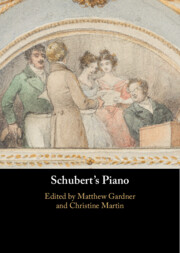Book contents
- Schubert’s Piano
- Schubert’s Piano
- Copyright page
- Contents
- Figures
- Tables
- Music Examples
- Notes on Contributors
- Acknowledgements
- Abbreviations and Conventions
- Introduction
- Part I The Piano in Schubert’s World
- 1 Franz Schubert as a Pianist
- 2 Between Society and Solitude: Schubert’s Improvisations
- 3 The Piano in Schubert’s Lied Texts
- 4 Schubert’s Four-Hand Piano Music
- Part II Instruments and Performance
- Part III Sound and Musical Imagery
- Part IV Understanding Schubert’s Writing for the Piano
- Select Bibliography
- Index
3 - The Piano in Schubert’s Lied Texts
from Part I - The Piano in Schubert’s World
Published online by Cambridge University Press: 31 August 2024
- Schubert’s Piano
- Schubert’s Piano
- Copyright page
- Contents
- Figures
- Tables
- Music Examples
- Notes on Contributors
- Acknowledgements
- Abbreviations and Conventions
- Introduction
- Part I The Piano in Schubert’s World
- 1 Franz Schubert as a Pianist
- 2 Between Society and Solitude: Schubert’s Improvisations
- 3 The Piano in Schubert’s Lied Texts
- 4 Schubert’s Four-Hand Piano Music
- Part II Instruments and Performance
- Part III Sound and Musical Imagery
- Part IV Understanding Schubert’s Writing for the Piano
- Select Bibliography
- Index
Summary
The word ‘Klavier’ occurs only twice in the texts of Schubert’s lieder, but both times in a prominent position – namely, in the titles of Christian Daniel Friedrich Schubart’s ‘An mein Klavier’ and Friedrich Schiller’s ‘Laura am Klavier’, both set to music in 1816 (respectively D342 and D388). The first poem deals with two figures – the narrative persona and his piano; the second with three – Laura, the piano and the narrative persona. In Schubart, the emphasis falls on the piano’s expressive potential; in Schiller, mainly on the impression it imparts. The two poems thus present the instrument in quite different, even antithetical, guises: introverted versus extroverted. Although Schubert turned to poems that were already a generation old (they were first published in 1785 and 1782, respectively) and had a different sound in mind compared to the two poets (this was an age of rapid evolution in keyboard instrument construction), the instrumental aesthetic displayed in Schubart’s and Schiller’s poems still applied with undiminished force in 1816. The antitheses marked by the poems Schubert chose with respect to the Klavier reveal the breadth of notions associated with the instruments that went by that name around 1800.
- Type
- Chapter
- Information
- Schubert's Piano , pp. 50 - 69Publisher: Cambridge University PressPrint publication year: 2024

